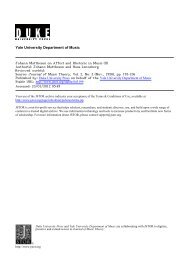Après une Lecture de Liszt: Virtuosity and ... - Free
Après une Lecture de Liszt: Virtuosity and ... - Free
Après une Lecture de Liszt: Virtuosity and ... - Free
Create successful ePaper yourself
Turn your PDF publications into a flip-book with our unique Google optimized e-Paper software.
19THCENTURYMUSICplanned improvisation. MS I 18, no.1 (plate 1),ca.1839, presents the opening tritones, whichestablish a <strong>de</strong>monic topic of <strong>de</strong>scent whollyappropriate to the journey into hell that initiallyinspired the artistic conception. 18 Laterrevisions to this passage in manuscripts from1840 to 1858 are cosmetic. 19 Dated 11 March1840, MS 1C.51 (plate 2), a manuscript hithertounconnected to the “Dante” Sonata, shows asketch of the Sonata’s characteristic majorchordprogression written in the Stammbuchof a female admirer in Prague, suggesting that<strong>Liszt</strong> may have performed it there <strong>and</strong>, on request,copied this music after the fact. 20 Curiously,the progression is notated in C whereasit occurs (substantively) in both F ♯ <strong>and</strong> D in theearliest complete manuscript ca.1840 (MS I 76),where it forms the basis of a thematic <strong>and</strong>modal contrast with the main chromatic themein the Sonata’s later versions (compare with ex.6). This discrepancy of key could represent akindly simplification by <strong>Liszt</strong> for an admiringamateur, but it may also suggest a characteristicallyimprovisatory performance in Praguethat was more tonally discursive than MS I 76records.The final version of the Sonata, entitled <strong>Après</strong><strong>une</strong> lecture du Dante—Fantasie quasi Sonata,was first published by Schott in 1858 as theseventh <strong>and</strong> final piece in the second volume(Deuxième Année, Italie) of <strong>Liszt</strong>’s collection18MS I 18, no.1 is in the Goethe- und Schiller-Archiv,Weimar. A transcription of this fragment was first publishedin the Journal of the British <strong>Liszt</strong> Society 28 (2003),34.19See Appendix A for a stemmatological study of theSonata’s extant sources.20<strong>Liszt</strong> wrote to Marie d’Agoult the same day he signed themanuscript (Wednesday, 11 March 1840), explaining thathe had just given his fifth concert in Prague that morning.His comment that “the Bohemian aristocracy . . . havebeen most charming to me. Here, as elsewhere, the womenare on my si<strong>de</strong>,” makes it plausible that the notated chordprogression from the “Dante” Sonata may have been writtenfor a female aristocrat following a performance(L’aristocratie <strong>de</strong> Bohême . . . a été charmantissime pourmoi. Ici comme ailleurs, les femmes sont pour moi). SeeCorrespondance / Franz <strong>Liszt</strong>, Marie d’Agoult, ed. SergeGut <strong>and</strong> Jacqueline Bellas (Paris: Fayard, 2001), p. 551. In1962 a facsimile of this, MS 1C.51, was published in acollection of facsimiles with the text: “Ein Adagio, das<strong>Liszt</strong> einer unbekannten Prager Verehrerin ins Stammbuchschrieb.” See Alexan<strong>de</strong>r Buchner, Franz <strong>Liszt</strong> in Böhmen(Prague: Artia, 1962), p. 83.Années <strong>de</strong> Pèlerinage. 21 All four principalsources for the Sonata are now housed in theGoethe- und Schiller-Archiv in Weimar; 22 the1840 fragment from Prague, plate 2, is in thePrague State Conservatoire. <strong>Liszt</strong>’s original exemplarfor MS I 76 from ca. 1840 is lost, <strong>and</strong> allbut one of the sources from which I have workedare copyist’s versions; all show his corrections,alterations, <strong>and</strong> revisions. By studying thesedocuments, <strong>and</strong> following extensive researchby Rena Mueller into <strong>Liszt</strong>’s manuscripts, Ihave been able to update Sharon Winklhofer’sstudy from 1977 <strong>and</strong> chart the evolution of theSonata from its origins in 1839 as a sketchentitled Fragment dantesque. 23 The genetic <strong>and</strong>stemmatological information is presented inAppendix A (pp. 92–93), <strong>and</strong> Table 1; fig. 1gives a chronology of the copyists in the productionof the known manuscripts.The revisions <strong>and</strong> evi<strong>de</strong>nt preparation ofmanuscripts between 1839 <strong>and</strong> 1840, 1849 <strong>and</strong>21<strong>Liszt</strong> used four different titles in the preparation of hismanuscripts, all of which suggest an explicitly literaryconception: “Fragment dantesque” connotes an unfinishedform that, for Romantic poetry in particular, pointed tothe infinite by its very incompleteness; “Paralipomènes àla Divina Comedia” means material omitted from the bodyof a text, appen<strong>de</strong>d as a supplement; “Prolégomènes à laDivina Comedia” indicates that <strong>Liszt</strong> changed his mind,preferring not to append but to preface his music to areading of the text; “<strong>Après</strong> <strong>une</strong> lecture du Dante: Fantasiequasi Sonata” is <strong>de</strong>rived from Victor Hugo’s poem of almostthe same name from the collection Les Voixintérieures (1837) <strong>and</strong> allowed <strong>Liszt</strong> to characterize hisrelation to Beethoven with the subtitle. <strong>Liszt</strong>’s use of “du”rather than Hugo’s “<strong>de</strong>” in the final title is most likely<strong>de</strong>liberate, drawing on the German practice of using the<strong>de</strong>finite article to refer to a famous person or thing, <strong>and</strong>attempting to translate this into French. In a letter toJoachim Raff from 1 August 1849, <strong>Liszt</strong> refers to his pieceas Fantasia quasi Sonata (Prologomènes [sic] zu DantesGöttlicher Comödie), but this title is not, to my knowledge,recor<strong>de</strong>d in any of the extant manuscripts. Raff’sletter is cited in Sharon Winklhofer, “<strong>Liszt</strong>, Marie d’Agoult<strong>and</strong> the ‘Dante’ Sonata,” this journal 1 (1977), 30.22In chronological or<strong>de</strong>r, these are MSS I 18, no.1; I 18,no.3; I 76; I 17; I 18, no.2; I 137 7 . See Appendix A for anexplanation of the sources, the findings of which are presentedschematically here as fig. 1.23Rena Mueller, <strong>Liszt</strong>’s “Tasso” Sketchbook: Studies inSources <strong>and</strong> Revisions (Michigan: UMI, 1986), pp. 147–54.See also Sharon Winklhofer, <strong>Liszt</strong>’s Sonata in B Minor: AStudy of Autograph Sources <strong>and</strong> Documents (Ph.D. diss.,University of California, Los Angeles, 1978), subsequentlypublished (Ann Arbor: UMI Research Press, 1980), pp. 53–84, <strong>and</strong> Winklhofer’s shorter study of the “Dante” Sonata,“<strong>Liszt</strong>, Marie d’Agoult, <strong>and</strong> the ‘Dante’ Sonata.”56



